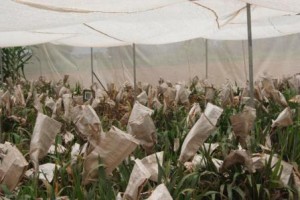By Rose SM Gidado*

Humans have been genetically modifying plants and animals for thousands of years through selective cross-breeding and domestication. Prior to the 1970s, it was primarily conducted by selecting the seeds of the best crops to sow each year, which eventually created relatively uniform strains of crop plants.
Through hybridization, farmers were also able to create offspring that share the most beneficial traits of both parent lineages, including plants that grew taller, larger beef cattle, or longer blooming flowers. These methods are still used today.
Genetic modification or engineering is simply the removing, modifying, or adding genes to a DNA molecule [of an organism] in order to change the information it contains. By changing this information, genetic modification changes the type or amount of proteins an organism is capable of producing, thus enabling it to make new substances or perform new functions.
Genes are the pieces of DNA code, which regulate all biological processes in living organisms. The entire set of genetic information of an organism is present in every cell and is called the genome.
In conventional breeding, half of an individual’s genes come from each parent, whereas in genetic modification one or several specially selected genes are added to the genetic material. Moreover, conventional plant breeding can only combine closely related plants.
Genetic modification permits the transfer of genes between organisms that are not normally able to cross breed.
For example a gene from a bacterium can be inserted into a plant cell to provide resistance to insects. Such a transfer produces organisms referred to as genetically modified (GM) or transgenic. In more than 30 per cent of all arable land, primarily in developing countries, aluminium can be present in the soil in a form that limits plant growth. To prevent these harmful effects, the usual approach is to add lime to the soil to reduce its acidity. However, this measure is costly and its benefits are temporary, because the aluminium remains in the soil. A new approach consists of developing new varieties of plants that are more tolerant to aluminium. For example, rye is four times more resistant to aluminium than wheat. A gene controlling aluminium tolerance in rye was identified and its position on the genome determined. Knowing the location of this gene in rye can help locate it in other crops such as wheat. Thus within a crop species individual plants which are more resistant than others to aluminium could be identified and selected for further breeding. Alternatively, the gene could also be transferred from rye to other closely related species such as wheat.
One of the most widespread uses of genetic modification is the development of crops resistant to common insect pests; others include herbicide resistance, drought tolerance, and foods with enhanced nutritional values. In 1994, the first food products from this technology began reaching the market, including the FlavrSavr tomato and a breed of potatoes genetically modified to produce an insect-killing protein. For commercial reasons, neither is available today.
Today more than 20 different crops, including soybeans, corn, cotton, and canola, contain genetically modified varieties. Over the past decades, the land area dedicated to GM crops has increased more than 100-fold.
According to ISAAA Global Update, 2014, Biotech crop hectares were planted in 28 countries in 2014 and hectarage has increased more than 100-fold from 1.7 million hectares in 1996 to 181.5 million hectares in 2014 – a 6.3 million hectare increase compared to 5.0 million hectares in 2013 at an annual growth rate of between 3 to 4%.
A 100-fold increase makes biotech crops the fastest adopted crop technology in recent times – the reason – they deliver benefits. Number of biotech countries has more than quadrupled from 6 in 1996 to 28 in 2014, up one from 2013.
There are many benefits to genetic modification, including a reduction in the need for some pesticides and increases in yield and nutrient production. Social and economic benefits addressing health problems, such as Vitamin A deficiencies, are possible through the creation of nutritionally-enhanced crops (not yet available). Even more revolutionary, is the recent development of a salt-tolerant tomato. The breakthrough could ultimately transform barren, salt-laden soils into arable land.
A new 2014 global meta-analysis confirmed significant multiple benefits, during the last 20 years. A global meta-analysis of 147 studies in the last 20 years, confirmed that “on average GM technology adoption has reduced chemical pesticide use by 37%, increased crop yields by 22%, and increased farmer profits by 68%.” These findings corroborate earlier and consistent results from other annual global studies.
The latest provisional data for 1996 to 2013, showed that biotech crops contributed to Food Security, Sustainability and Environment/Climate Change by: increasing crop production valued at US$133 billion; providing a better environment, by saving Rs 500 million kg a.i. of pesticides from 1996 to 2012; in 2013 alone reducing CO2 emissions by 28 billion kg, equivalent to taking 12.4 million cars off the road for one year; conserving biodiversity by saving 132 million hectares of land from 1996-2013; and helped alleviate poverty for >16.5 million small farmers and their families totaling >65 million people, who are some of the poorest people in the world.
Biotech crops are essential but are not a panacea – adherence to good farming practices such as rotations and resistance management, are a must for biotech crops as they are for conventional crops.
However, there are also potential risks; the most serious being the possibility of passing genes from genetically modified crops into their wild relatives and imparting properties that affect their spread and survival (also a risk for conventional plants). Other risks include the ability of pests to evolve resistance to the toxins produced by genetic modification and the concern over whether such modification would increase or decrease the potential for allergic reactions.
All the risks to date are speculative, but scientific studies are ongoing to assess potential risk. Insect and weed resistance are occasionally reported for engineered plants; these types of resistance are not unexpected and are common for conventional insecticides and herbicides. Relative to conventional plants, genetically modified crops often undergo extensive laboratory and field-testing to be approved for use.
In Nigeria, the National Biosafety Management Agency (NBMA) under the Federal Ministry of Environment is the National Competent Authority for the regulation to ensure safe practice of genetic modification and safe use of genetically modified crops/foods. Biotechnology has also become an important trade issue, because the U.S. exports more than 50 percent of the wheat and rice that it produces, and more than 25 percent of its corn, soybean, and cotton crops. Although there is no credible evidence of health risks to date, there continues to be considerable consumer and government resistance to GM foods across the globe.
(To be continued)
* Rose S M Gidado (PhD), is the Coordinator, Open Forum on Agricultural Biotechnology (OFAB) in Africa, Nigeria Chapter
Mrs. Rose Suniso Maxwell Gidado.
 Mrs. Rose Suniso Maxwell Gidado was born on the 16th of April 1966 in Yola, Adamawa State of Nigeria. She attended Federal Government Girls’ College Yola, Adamawa State, 1979-1984 and proceeded to the Federal Polytechnic Mubi, Yola Campus, 1987-1989. She then went to University of Maiduguri, Maiduguri, 1990-1995, where she obtained B.Sc. in Food Science & Technology. She obtained her M.Sc and PhD in Microbiology at the University of Abuja.
Mrs. Rose Suniso Maxwell Gidado was born on the 16th of April 1966 in Yola, Adamawa State of Nigeria. She attended Federal Government Girls’ College Yola, Adamawa State, 1979-1984 and proceeded to the Federal Polytechnic Mubi, Yola Campus, 1987-1989. She then went to University of Maiduguri, Maiduguri, 1990-1995, where she obtained B.Sc. in Food Science & Technology. She obtained her M.Sc and PhD in Microbiology at the University of Abuja.
Mrs. Gidado has worked in various organizations (NASCO Foods Nigeria Limited, Agro Products Nigeria Limited, Sheda Science Technology Complex) and is presently an Assistant Director/Coordinator, Open Forum on Agricultural Biotechnology (OFAB) Nigeria Chapter, National Biotechnology Development Agency, Abuja, Nigeria. She has established several collaboration and linkages with relevant national and international governmental and non-governmental organizations that will promote the development of biotechnology in the country and have also maintained the Linkages.
OFAB is a knowledge-sharing and awareness-enhancing outfit for improved understanding and appreciation of agricultural biotechnology by stakeholders and decision makers. Through OFAB, I stirred the passage of the Bio-safety Bill passage process and got it passed at the National Assembly in 2010 and 2011 respectively.
The Sensitization Programmes held enlightened the Legislators and the general public on the need for Nigeria to have a Biosafety Law despite the negative influence of environmentalists and poor public understanding of Biotech operations and procedures.
Mrs. Gidado has over 19 scientific publications in both local and international journals and 26 paper presentations at seminar and conference. She is a member of four professional bodies (Biotechnology Society of Nigeria, African Society for Toxicological Sciences, Nigerian Institute for Food Science & Technology and Genetic Society of Nigeria).




